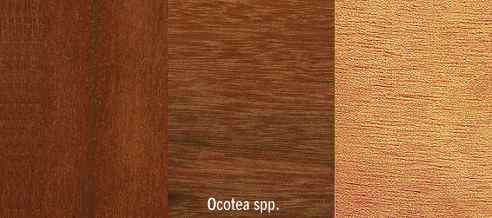
Camphre noir (Ocotea comoriensis)
Family: Lauraceae
Common names: Camphre noir, E. African black camphorwood
Distributed in: Comoros (Africa)
Distribution overview: The species is indigenous to the Comoro Islands.
Common uses: Balusters, Boat building, Building construction, Building materials, Cabin construction, Canoes, Chairs, Chests, Concealed parts (Furniture), Construction, Decorative plywood, Desks, Dining-room furniture, Domestic flooring, Dowell pins, Dowells, Drawer sides, Excelsior, Factory construction, Factory flooring, Fine furniture, Floor lamps, Flooring, Furniture , Furniture components, Furniture squares or stock, Hatracks, Heavy construction, Interior construction, Interior trim, Joinery, Kitchen cabinets, Lifeboats, Light construction, Living-room suites, Millwork, Mine timbers, Moldings, Office furniture, Parquet flooring, Plywood
Environment profile: Status has not been officially assessed
Tree size: Trunk diameter is 100-150 cm
Colors: the heart isRed, Yellowand the sapwoodWhite, Yellow.The grain isWavy, the textureMediumand the lusterMedium
Natural durability: Resistant to termites, Susceptible to insect attack
Odor: Freshly sawn timber may have unpleasent odor, which fades with seasoning
Drying Defects: Distortion, End splitting
Ease of Drying: Quartersawn material yields the best results
Comments: Oil Cells - Timber occasionally contains tyloses and oil cells.
Blunting Effect: Slight dulling effect on cutting tools
Cutting Resistance: Low cutting resistance
Gluing: Good gluing properties
Nailing: Good nailing characteristics
Planing: Slight dulling effect on cutting edges
Resistance to Impregnation: Sapwood is moderately resistant
Response to hand tools: Slight dulling effect on cutting edges
Sanding: Good sanding properties
Screwing: Good screwing properties
;
Painting: Very Good to Excellent; Polishing: Very Good to Excellent; Staining: Very Good to Excellent;
- Numerical data Metric
- Numerical data English
- Strength properties
- References
 |
 |
 |
 |
| Item |
Green |
Dry |
Metric |
| Specific Gravity |
|
|
|
| Density |
|
|
kg/m3 |
| Bending Strength |
620 |
995 |
kg/cm2 |
| Crushing Strength |
310 |
501 |
kg/cm2 |
| Hardness |
|
|
kg |
| Impact Strength |
|
|
cm |
| Shearing Strength |
|
130 |
kg/cm2 |
| Stiffness |
106 |
124 |
1000 kg/cm2 |
| Tangential Shrinkage |
|
|
% |
| Radial Shrinkage |
|
|
% |
| Weight |
|
|
kg/m3 |
| Maximum Load |
|
|
cm-kg/cm3 |
| Toughness |
|
|
cm-kg |
| Static Bending |
|
|
kg/cm2 |
|
 |  |  |  | | Item | Green | Dry | English | | Bending Strength | 8820 | 14161 | psi | | Maximum Crushing Strength | 4410 | 7130 | psi | | Shearing Strength | | 1862 | psi | | Stiffness | 1519 | 1764 | 1000 psi | | Specific Gravity | 0.28 | 0.51 | | |
Compression strength (parallel to grain) = high
Bending strength (MOR) = high
The species has high bending strength in the air-dry condition (about 12 percent moisture content). It compares favorably with Teak, which also has high bending strength. Maximum crushing strength, or compression strength parallel to grain, is high. Some familiar species with high crushing strength parallel to grain include Hard maple, Teak, and White oak
Bolza, E., Keating, W.G.,1972,African Timbers - the Properties, Uses and Characteristics of 700 Species,C.S.I.R.O. Div. of Building Research
|








